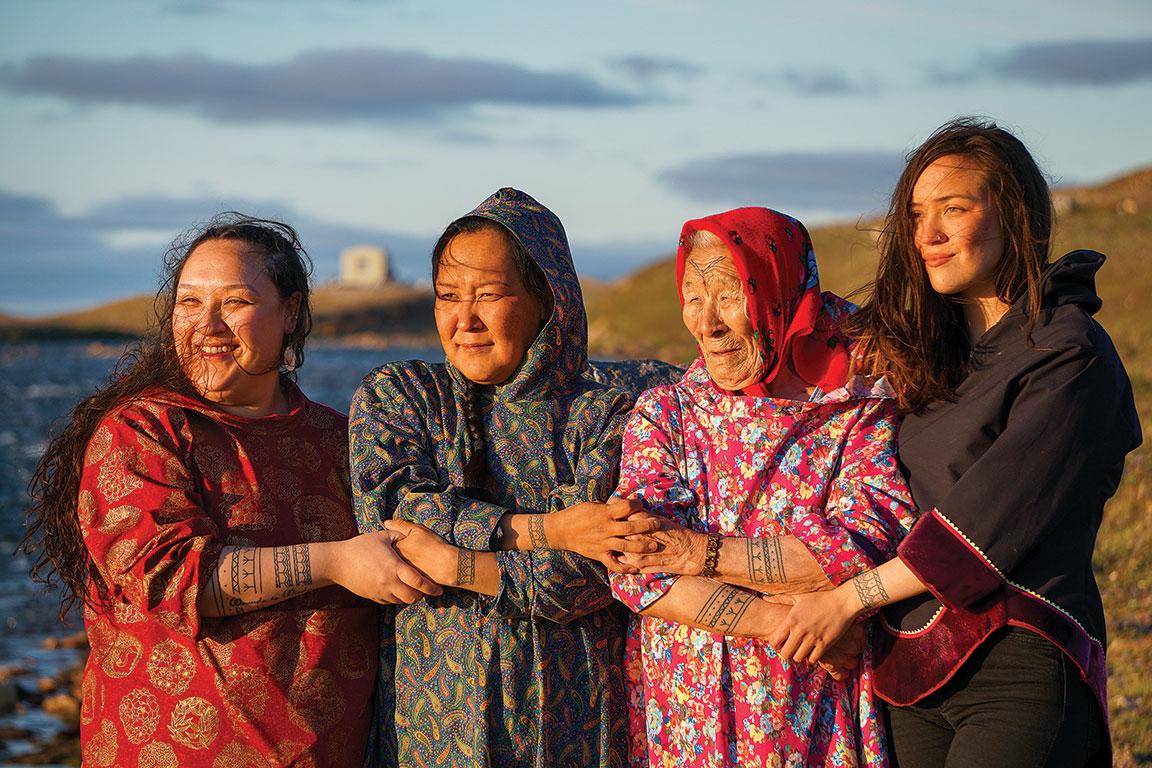Inuit tattoos, or kakiniit, were once banned. Now they are worn with pride.

With photography by Denise Peterson
July 26, 2021
A river intertwined in legend as old as time runs gently from Iqaluktuuttiaq Lake to the Arctic Ocean — and nestled along the estuary among low-rolling hills is my hometown, Iqaluktuuttiaq (Cambridge Bay). This river, or kuugaq as we say in our mother tongue, Inuinnaqtun, is a popular spot to fish all months of the year. So too is the enormous lake it runs from and the ocean they flow to. Ovajuq is a legend that shares the story of a family of giants that lived on Kiilinik Island long, long ago. They starved to death and formed our three mountains; their bladders had burst and eventually formed the many streams, rivers and lakes found on Kiillinik Island, our home.
Much like our knowledge that has seen us through thousands and thousands of years, some of our kakiniit — traditional Inuit tattoos — are still being passed down from generation to generation. I often find myself wondering: what lands did our birthright markings travel and which waters did they navigate when we Inuit lived a solely nomadic lifestyle? Some tattoos fuse modern with traditional designs; others are older than Canada, older than the borders separating Inuit Nunangat, older than the English language. Hand-poking today consists of poking modern tattoo ink into the skin, one dot at a time, whereas skin-stitching is a method where a needle and thread dipped in ink is sewn through the skin and leaves a mark that darkens as it heals — methods older than any books we can find information on kakiniit in.
Our markings survived the years they were banned by our colonizers. Now our beautiful markings are being proudly worn, coming out of secrecy, filling up spaces and faces. Whether they are hand-poked, skin-stitched or machine work, they are always only for Inuit to wear. Our kakiniit are here to stay. Never to be banned again. Never to carry shame again.


It was no surprise that Tammy, granddaughter of Matriarch Bessie Pihuak Omilgoetok and the late Paul Omilgoetok, agreed to have her family’s photo shoot at “the River,” where Tammy is often seen casting her rod with the midnight sun.
Eight o’clock in the evening in mid-August above the Arctic Circle is filled with pastel skies and a sun that we’re getting used to seeing set once again after a summer with 24-hour sunlight. A perfect night not only to honour kakiniit but also to honour some of the women who wear them proudly, so willing to share with the world, with you. Letting beauty flow like the kuugaq, we all laughed on that brisk, late summer evening. It was important to photographer Denise Peterson and me to work with Pihuak first and foremost because she is the oldest tattooed woman in our community, wearing her traditional forehead and wrist markings at the age of 81 — markings she remembers her great-grandmother wearing, and now she wears them along with three of her granddaughters.
It was as if time had stopped or slowed down — even the undulating kuugaq stream seemed to have paused in awe. One by one, the captivating and eloquent Matriarch Pihuak and her family arrived and made their way riverside. I was completely mesmerized and wondered if the fish swimming beside us also halted mid-water to see four generations of Omilgoetok women and children dressed in their best hand-sewn outfits, with the wind helping itself, dancing in their hair. Head to toe in Inuit beauty. For one of Pihuak’s granddaughters, Genevieve, her wrist markings from her great-great-great-grandmother bring a sense of pride and identity. It’s a statement that her family is still here. And they aren’t going anywhere.

Continue reading this article on Canadian Geographic.


